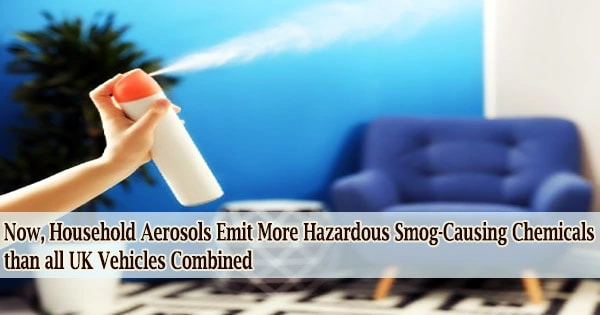According to new research, household aerosol items now generate more dangerous volatile organic compound (VOC) air pollution than all the automobiles combined in the UK.
According to a recent study by the University of York and the National Centre for Atmospheric Science, the use of disposable aerosols by the world’s population, which has increased to over 25 billion cans annually, is harming the environment globally.
More than 1.3 million tonnes of VOC air pollution are predicted to be released annually as a result of this, and that number may increase to 2.2 million tonnes by 2050.
Volatile organic compounds (VOCs), which are also generated from fuel and automobiles, make up the majority of the chemicals utilized in compressed aerosols nowadays. According to the study, the ozone-depleting CFCs that VOCs replaced in the 1980s were more harmful than the VOCs that are currently utilized in aerosols.
However, no one anticipated such a significant increase in global consumption in the 1980s, when important decisions about international policy were taken. When sunshine is present, VOCs and a second pollutant, nitrogen oxides, combine to form photochemical smog, which is bad for human health and hurts crops and plants.
Gasoline cars and fuel were by far the biggest contributor to VOC pollution in the UK in the 1990s and 2000s, however, controls like catalytic converters on cars and fuel vapour recovery at filling stations have significantly decreased these emissions in recent years.
According to research, personal care products account for the majority of the 10 cans of aerosol that are used annually per person in high-income countries. Aerosol emissions are rising globally as economies in low and middle-income countries expand and citizens of these nations make more purchases.
Labelling of consumer products as high VOC emitting and clearly linking this to poor indoor and outdoor air quality may drive change away from aerosols to their alternatives, as has been seen previously with the successful labelling of paints and varnishes.
Professor Alastair Lewis
The authors of the paper are urging global decision-makers to decrease the use of VOCs in compressed aerosols, either by promoting the use of less harmful propellants like nitrogen or non-aerosol versions of items. Approximately 93% of aerosol cans currently use VOCs.
Professor Alastair Lewis from the Department of Chemistry and a Director of the National Centre for Atmospheric Science said:
“Virtually all aerosol-based consumer products can be delivered in non-aerosol form, for example as dry or roll-on deodorants, bars of polish not spray. Making just small changes in what we buy could have a major impact on both outdoor and indoor air quality, and have relatively little impact on our lives.”
“The widespread switching of aerosol propellant with non-VOC alternatives would lead to potentially meaningful reductions in surface ozone. Given the contribution of VOCs to ground-level pollution, international policy revision is required and the continued support of VOCs as a preferred replacement for halocarbons is potentially not sustainable for aerosol products longer term.”
According to the paper, there are currently non-aerosol substitutes that can be used in liquid or solid form and are simple to apply, such as roll-on deodorant, hair gel, solid furniture polish, bronzing lotion, and room scent.
The authors of the study draw the conclusion that consumers’ prolonged usage of aerosols in the face of non-aerosol options is frequently the result of ingrained consumer behaviors. And that when communicating to the public about air pollution and its control, the function played by aerosol VOC emissions in air pollution needs to be much more clearly stated.
Professor Lewis added: “Labelling of consumer products as high VOC emitting and clearly linking this to poor indoor and outdoor air quality may drive change away from aerosols to their alternatives, as has been seen previously with the successful labelling of paints and varnishes.”
The study, which incorporated information from global industry and regulatory authorities, was co-authored by Wolfson Atmospheric Chemistry Laboratories PhD student Amber Yeoman.
















